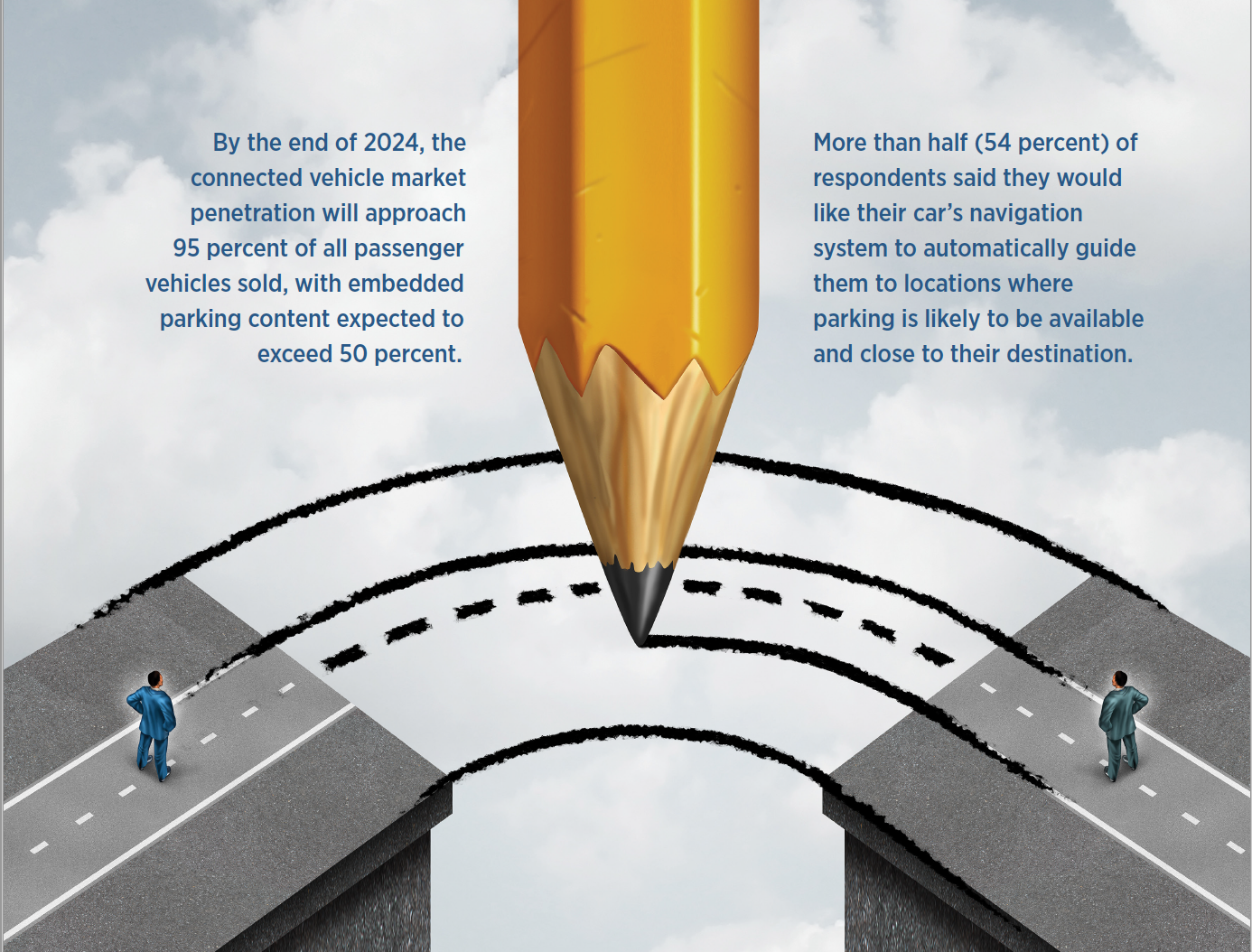Bridging the Gap: How Parking Operators & Auto Brands Can Work Together

There is currently a gap between parking operators (cities, universities, airports, private operators, etc) and auto manufacturers, in terms of understanding how current and future connected cars will interact with today’s parking infrastructure. While there are a number of factors that contribute to this chasm, one of the more important factors impacting the parking industry is the deployment timeline for in-vehicle connected services as they relate to parking.
Based on stated production programs, the proportion of connected cars in North America currently stands at 50% in 2019, with only a small percentage of vehicles featuring parking related content embedded within the vehicle. However, the number of connected vehicles hitting the roadway is projected to grow significantly year over year over the next five years. By the end of 2024, the connected vehicle market penetration will approach 95% of all passenger vehicles sold with embedded parking content expected to exceed 50%.
Despite the anticipated growth of connected vehicles, it is understandably challenging for parking operators to prepare for a new type of driving and parking experience which is still being developed by the multi-national, multi-billion dollar automotive manufacturers. One thing for certain however, is that manufacturers are investing millions of dollars in connected services, and “parking” is a key feature the auto manufacturers seek to leverage to improve driver engagement and experience. As these services come online, it is important for the parking industry to understand what can be done today within your operations to support a connected car’s ability to search for, navigate to, and pay for parking.
Parkopedia recently conducted research on driver future wants and needs as it relates to parking and the level of decision-making the car can do on the driver’s behalf. More than half (54%) of respondents said they would like their car’s navigation system to automatically guide them to locations where parking is likely to be available and close to their destination. A similar number (51%) said they would like their navigation system to make personalized parking recommendations. This is no surprise considering there is a long tail of criteria other than price or distance which have high importance for individual drivers, including height restrictions, availability of disabled parking and EV charging.
With so much anticipated control being handed over to the car, it is essential that parking operators develop a plan to maximize the opportunity to support connected vehicles and their drivers. This can be achieved in 3 ways:
- Democratizing data: Consumers require reliable and accurate information, including details around location, pricing, facilities including electric vehicle charging points, likely availability, and more. The car manufacturers are already integrating with the likes of Parkopedia (and others) to make this data available to drivers in the car. By taking the necessary steps to digitize your static and dynamic location data, you will be well-positioned to share your content to millions of drivers using embedded navigation systems, mobile applications, and parking location data aggregators.
- Multi-credential support: With the parking industry being unlikely to standardize, it is safe to assume the automotive companies are looking at several different ways for vehicles and drivers to actuate a gate. This can include supporting embedded vehicle credentials such as license plates, bluetooth technologies, and RFID. Other credentials may be embedded within the automotive manufacturer’s mobile companion application (such as MercedesMe); these credentials include quick response (QR) and barcode support as well as bluetooth. As we look ahead, if a parking location requires the use of gate arms to control access, then operators need to consider technology providers that allow for the greatest flexibility to interact with the connected vehicle network to ensure a frictionless parking experience.
- Open transactions: Automotive manufacturers want to provide drivers with a ubiquitous transaction experience, through a single “parking” application within the vehicle ecosystem. These manufacturers do not have the desire or bandwidth to manage integrations with dozens of payment service providers on a global or regional scale. Some of Parkopedia’s customers, for example, prefer a service provider that has the ability to integrate with multiple payment channels to give their drivers complete coverage across a respective region.
As parking professionals, we need to be conscious of the fact that a multi-billion dollar industry intends to alter the way drivers search for, navigate to and pay for parking. This will inevitably change the way we manage our operations as well as select technologies that will ensure the best parking experience possible. Those parking operators who maintain an open mind as to how connected vehicles will influence parking behavior and prepare accordingly will be best positioned to drive customers to their properties.
This article first appeared in IPMI's Parking & Mobility magazine, Jan 2020 issue
Latest Parkopedia News & Technology Articles
.png?width=1960&height=1103&name=parkopedia%20logo%20+%20arrive%20(1).png)